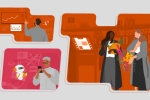How the trucking industry is becoming more sustainable—and increasing returns—through Industry 4.0
5G network infrastructure and IoT devices are helping transport firms reduce emissions and lower costs
With businesses under growing pressure to map out their paths to decarbonization, the trucking industry and other high-emitting sectors are increasingly finding themselves in the spotlight.
The transport industry, which includes passenger vehicles, aviation and shipping, is responsible for approximately one-fifth of global carbon dioxide emissions.1 But within that segment, commercial trucks made up 29.4% of transport emissions in 20182—part of a broader sustainability challenge facing the industry.3
For many organizations, sustainability challenges are increasingly becoming business challenges. Consumers4, investors5 and other stakeholders want to engage with businesses that take climate change and other sustainability issues seriously. And as organizations respond by developing credible plans to reach net-zero emissions, trucking companies may find their operating models under additional pressure as their clients scrutinize the carbon footprint of their own supply and value chains to reduce so-called “scope 3” emissions.
But against this backdrop, a new generation of technological tools and platforms are providing transport firms with real-time insights into their operations—helping them find efficiencies, reduce emissions, respond to rising customer expectations and differentiate themselves in a fragmented, hyper-competitive market.
Building the business case
5G network infrastructure is becoming the backbone of Industry 4.0 and the end-to-end digitization of physical assets that’s helping businesses uncover new opportunities and reimagine their business models.
Many transportation and logistics companies, including those with relatively small fleets or more traditional operating models, may perceive the cost and sheer scale of such digitization investments to be prohibitive. But pursuing a full-scale digital transformation is far from the only option. Companies can often build a business case around investing in specific digitization efforts and services that yield both tangible and intangible returns at a more manageable cost.
Systems that enable dynamic routing, for example, can directly improve a logistics firm’s bottom line by lowering fuel consumption. At the same time, it can also help attract and retain sustainability-minded clients when the technology is part of a company’s wider environmental, social and governance (ESG) strategy and public reporting.
We’re seeing how evolving customer demands are driving technology investments in the transportation and logistics industry. In some cases, this is creating opportunities for early adopters to stand out in a competitive market through differentiated services, such as giving customers the option to pay a premium for a low-carbon, greener delivery model.
Elsewhere, companies are investing in tools that provide full order and delivery visibility—a service offering driven by growing customer expectations to be able to see when a package leaves a warehouse, when it arrives in their community and when it’s expected to be delivered. Transportation companies that are slow to adapt new digital tools risk ceding market share to their competitors as well as customers, particularly in the retail industry where some companies are growing their own logistics capabilities.

How fleet operators are capitalizing on Industry 4.0, IoT and 5G
We’ve seen how combining the right technologies with a strategy-led plan, transformational change and transparent reporting helps organizations build trust with stakeholders and deliver sustained outcomes. And some leaders in the logistics industry are already seeing financial and environmental returns.
In the UK, for example, Royal Mail has implemented IoT technology into more than 20,000 of its postal and courier service vehicles. The devices monitor the vehicles’ acceleration, speed, turning and braking patterns, encouraging safe and fuel-efficient driving by providing van operators positive feedback. Since 2019, Royal Mail has saved more than 177,000 litres of fuel, reducing its CO2 emissions by 459 tonnes.6
These same technologies can also increase sustainability in ways beyond emissions reduction. Take food waste, for example. Around the world, up to 60% of all fruits and vegetables end up in landfills.7 While there are a variety of contributing factors along the entire supply chain, gaps and inefficiencies in the transportation process can cause fresh food to spoil. These gaps can take a variety of forms, such as when food is left sitting on a loading dock because a refrigerated truck is late to pick it up. Or when a door on a refrigerated container is left ajar, or a truck breaks down because its scheduled maintenance was missed.
Last year, Amazon Web Services announced it was co-developing a digital platform called Lynx that combines IoT, machine learning and analytics to give logistics firms greater real-time visibility into their operations as well as recommendations to reduce food spoilage.8 Its vision includes improved fleet utilization, better truck routing and proactive alarms, all powered by an intelligent and connected temperature-controlled supply chain that improves reliability and reduces spoilage.
Overcoming roadblocks to accelerate industry adoption
The transportation industry is already one of the leading adopters of IoT. Industry researchers estimate that 42% of North American fleets will have implemented IoT technologies by the end of 2021.9 But, at the same time, this technology is being deployed unevenly.
Various trucking fleet operators are at different maturity points on their Industry 4.0 journey. On one side of the spectrum, some remain fully disconnected and reliant on manual processes. At the other end, more advanced organizations are operating fully integrated and connected fleets using AI and cloud technologies to digitally manage their business.
Some organizations encounter internal roadblocks when executing new digital strategies. But leaders should consider the following factors to help overcome common hurdles:
- Use cases and key prioritization. What are the key drivers and use cases? For the trucking industry, this might include driver data, cargo and vehicle operations. From there, it’s important to identify how you will develop the ROI and how it fits within your broader sustainability and business strategy.
- Ecosystem consolidation. A blended mix of hardware, software and services is required to implement new digital solutions. That becomes more complex within a fragmented space.
- Key partnerships. Organizations should possess the capabilities to manage a range of technology partners across the value chain.
- Implementation. What is the operational model to implement new digital capabilities and maintain technologies throughout the innovation life cycle?
- Workforce. It’s important to think about more than just technology. Don’t underestimate the need to adjust your organizational design as you move from a disconnected operating model to an integrated and agile organization that puts data and AI at the forefront of decision making.
5G and IoT to power a new era of transparency
The adoption of 5G and IoT will help individual trucking companies reduce emissions and operate more efficiently while simultaneously helping the broader logistics industry become more sustainable and transparent.
Freight terminals, for example, will be able to route trucks through their facilities more quickly, reducing congestion. And, for freight customers, 5G and IoT solutions in the supply chain can help deliver real-time carbon footprint monitoring and in-transit visibility—reducing sustainability risks and reporting challenges for companies looking to strengthen and reimagine their compliance program.
5G and IoT platforms are currently a differentiator for trucking companies looking to reduce emissions as well as build trust with customers, employees, investors and other stakeholders. Going forward, these new tools and capabilities will drive a competitive shift in operational efficiency and business monetization that turns sustainability into a source of long-term value.
Interested in uncovering the opportunities that 5G will bring to your organization? We can help you anticipate the impact of 5G, reimagine business models and adapt your service delivery. Reach out to start a conversation.
Contributor
1. “Cars, planes, trains: where do CO2 emissions from transport come from?,” Our World in Data, last modified Oct. 6, 2020, https://ourworldindata.org/co2-emissions-from-transport.
2. “Transport sector CO2 emissions by mode in the Sustainable Development Scenario, 2000-2030,” The International Energy Agency, last modified Nov. 22, 2019.
3. Robert G. Eccles, “The Importance Of The Transportation Sector To The Sustainable Development Goals,” Forbes, Aug. 14, 2019, https://www.forbes.com/sites/bobeccles/2019/08/14/the-importance-of-the-transportation-sector-to-the-sustainable-development-goals/?sh=6fb5513a6b24.
4. “Understanding the Canadian consumer of the moment,” PwC Canada, June 2021, https://www.pwc.com/ca/en/industries/consumer-markets/consumer-insights-2021-pulse-2.html#sustainability.
5. James Chalmers, Emma Cox and Nadja Picard, “The economic realities of ESG,” PwC Global, Oct. 28, 2021, https://www.pwc.com/gx/en/services/audit-assurance/corporate-reporting/esg-investor-survey.html.
6. Natalie Middleton, “Royal Mail rolls out telematics across van fleet to cut CO2 and enhance safety,” International Fleet World, February 2021, https://internationalfleetworld.com/royal-mail-rolls-out-telematics-across-van-fleet-to-cut-co2-and-enhance-safety/.
7. Daphne Ewing-Chow, “Fruit And Vegetable Spoilage Is A Hidden Contributor To Underdevelopment,” Forbes, Oct. 31, 2020, https://www.forbes.com/sites/daphneewingchow/2020/10/31/fruit-and-vegetable-spoilage-is-a-hidden-cause-of-underdevelopment/?sh=2585d74b6923.
8. “Carrier and AWS collaborate to reduce food spoilage across the cold chain,” Amazon Web Services, last modified Oct. 16, 2020, https://aws.amazon.com/blogs/industries/carrier-and-aws-collaborate-to-reduce-food-spoilage-across-the-cold-chain/.
9. Bart De Muynck, “2018 Market Guide for Transportation Mobility Technology,” Gartner Research, last modified July 30, 2018, https://www.gartner.com/en/documents/3884376/2018-market-guide-for-transportation-mobility-technology.
Contact us
















